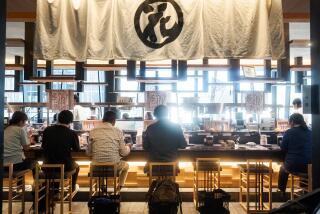DANCE REVIEW : Kabuki Troupe in U.S. Debut
- Share via
Dance is only one component in the multifaceted stage experience of the Grand Kabuki--but it is the focus of the Koryu Kabuki company, which made its American debut Sunday in Scottish Rite Auditorium.
This company of distinguished Japanese teachers (members of the Traditional Arts Exchange Society) did not neglect the theatrics of Kabuki dance: the spectacular scenery and sumptuous costumes. Indeed, the seven-part program stretched to nearly four hours largely due to the full set changes between selections.
Its major achievement, however, was allowing the public to appreciate Kabuki movement design--the traditional dance texts--without the extraordinary coloring that Grand Kabuki stars provide.
When Tamasaburo Bando V of the Grand Kabuki performs “Sagi Musume” (Heron Maiden), for instance, the stylization of man-into-woman-into-bird becomes so distilled in his overwhelming personal radiance, one is tempted to think of the piece solely as a vehicle. In contrast, the smaller scale but artful performance Sunday by Ms. Tokuya Azuma highlighted the structure and formal motifs of the solo: its refined choreographic craftsmanship.
Women, of course, do not appear in Grand Kabuki, but are prominent in Japanese classical dance--and many of the members of the Koryu group are related to dancers and musicians from the Azuma Kabuki company that pioneered this sort of programming in America back in 1954. Other leading dancers Sunday included Mitsujiro Bando, Sumi Hanayagi, Seizaburo Saruwaka, Chojuro Hanakawa, Shuho Fujima and Han Wakayagi, a woman taking a major male role.
Many of the pieces on the program involved startling transformations of identity (shrine dancer into dead courtesan in “Keisei Dojoji” and warrior into fox in “Yoshino Yama,” for example) or depicted attempts to hide or suppress passion (both of the above plus the mythic “Furyujin” and the farcical “Boshibari”).
Choreographed combat also turned up periodically--with “Gojyo Bashi” noteworthy because of its intricate fight-in-the-dark between a frightening master of weaponry and a noble youth armed with scarf, fan and parasol.
Throughout, fine musicianship (mostly on samisen and drum, with soulful singing) added to the unique atmosphere and intensity typical of Kabuki performance.
More to Read
The biggest entertainment stories
Get our big stories about Hollywood, film, television, music, arts, culture and more right in your inbox as soon as they publish.
You may occasionally receive promotional content from the Los Angeles Times.










